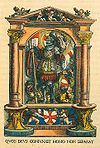Free Imperial City of Ulm
| Free Imperial City of Ulm | ||||||||||
| Freie Reichsstadt Ulm | ||||||||||
| Free Imperial City of the Holy Roman Empire | ||||||||||
|
||||||||||
|
The Free Imperial City of Ulm and surrounding area
|
||||||||||
| Capital | Ulm | |||||||||
| Government | Republic | |||||||||
| Historical era | Middle Ages | |||||||||
| • | Settlement founded | around 5000 BC | ||||||||
| • | Gained Reichsfreiheit | 1181 | ||||||||
| • | Großer Schwörbrief | 1397 | ||||||||
| • | Reformed to Protestantism | 1530 | ||||||||
| • | Truce of Ulm in Thirty Years' War |
1647 | ||||||||
| • | Mediatised to Bavaria | 1803 | ||||||||
| • | Annexed by Württemberg | 1809 | ||||||||
|
||||||||||
The Free Imperial City of Ulm was a Free Imperial City of the Holy Roman Empire. It is situated on the left bank of the Danube, in a fertile plain at the foot of the Swabian Jura.[1]
History
Ulm is mentioned as a demesne in 854, and under the Carolingian dynasty it was the scene of several assemblies. It became a town in 1027, and was soon the principal place in the Duchy of Swabia. Although burned down by Henry the Lion, the town soon recovered, becoming a Free Imperial City in 1155. Towards the close of the Middle Ages it played a leading part several times at the head of Swabian Leagues of the 14th century and 15th century. Its trade and commerce prospered, peaking in the 15th century, ruling over a district about 300 square miles. It became a Free Imperial City with extensive territorial authority, and having a population of about 60,000. It became Protestant in 1530 and declined after the French Wars of Religion of the 16th century and 17th century. In 1802 it lost its Imperial immediacy and passed to Electorate of Bavaria, being ceded to Kingdom of Württemberg in 1810. In October 1805 General Karl Mack von Leiberich and his 23,000 Austrian troops capitulated to Napoleon here. Ulm is remarkable in the history of German literature as the spot where the Meistersingers lingered longest, orally preserving the traditional folklore of their craft.
References
- ↑ Ulm. 2012. Encyclopædia Britannica Online. Retrieved 19 June, 2012, from http://www.britannica.com/EBchecked/topic/613251/Ulm
![]() This article incorporates text from a publication now in the public domain: Lua error in package.lua at line 80: module 'strict' not found.
This article incorporates text from a publication now in the public domain: Lua error in package.lua at line 80: module 'strict' not found.
- Former republics
- Former countries in Europe
- States of the Holy Roman Empire
- City-states
- Imperial free cities
- States and territories established in 1181
- States and territories disestablished in 1803
- Pages using infobox former country with unknown parameters
- Wikipedia articles incorporating a citation from the 1911 Encyclopaedia Britannica with no article parameter
- Articles containing German-language text
- Baden-Württemberg articles missing geocoordinate data
- Swabian League
- Former states and territories of Baden-Württemberg



